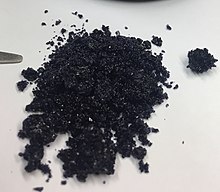Chromium(III) nitrate
 From Wikipedia the free encyclopedia
From Wikipedia the free encyclopedia
 Chemical structure of [Cr(H2O)6](NO3)3 | |
 Nonahydrate | |
| Names | |
|---|---|
| IUPAC name Chromium(III) nitrate | |
| Other names Nitric acid, chromium(3+) salt | |
| Identifiers | |
| |
3D model (JSmol) | |
| ChemSpider | |
| ECHA InfoCard | 100.033.550 |
PubChem CID | |
| RTECS number |
|
| UNII |
|
| UN number | 2720 |
CompTox Dashboard (EPA) | |
| |
| |
| Properties | |
| Cr(NO3)3 (anhydrous) [Cr(H2O)6](NO3)3•3H2O (nonahydrate) | |
| Molar mass | 238.011 g/mol (anhydrous) 400.21 g/mol (nonahydrate) |
| Appearance | Blue-violet crystals (anhydrous) Purple crystals (nonahydrate) |
| Density | 1.85 g/cm3 (nonahydrate) |
| Melting point | 60.06 °C (140.11 °F; 333.21 K) nonahydrate |
| Boiling point | > 100 °C (212 °F; 373 K) (decomposes) |
| 81 g/100 mL (20 °C) | |
| Hazards | |
| NFPA 704 (fire diamond) | |
| Flash point | Non-flammable |
| Lethal dose or concentration (LD, LC): | |
LD50 (median dose) | 3250 mg/kg (rat, oral, nonahydrate) 110 mg/kg (mouse, oral)[1] |
| Safety data sheet (SDS) | Oxford MSDS |
Except where otherwise noted, data are given for materials in their standard state (at 25 °C [77 °F], 100 kPa). | |
Chromium(III) nitrate describes several inorganic compounds consisting of chromium, nitrate and varying amounts of water. Most common is the dark violet hygroscopic solid. An anhydrous green form is also known. Chromium(III) nitrate compounds are of a limited commercial importance, finding some applications in the dyeing industry.[2] It is common in academic laboratories for the synthesis of chromium coordination complexes.
Structure
[edit]The relatively complicated formula - [Cr(H2O)6](NO3)3•3H2O - betray a simple structure of this material. The chromium centers are bound to six aquo ligands, and the remaining volume of the solid is occupied by three nitrate anions and three molecules of water of crystallization.[3]
Properties and preparation
[edit]The anhydrous salt forms green crystals and is very soluble in water (in contrast to anhydrous chromium(III) chloride which dissolves very slowly except under special conditions). At 100 °C it decomposes. The red-violet hydrate is highly soluble in water. Chromium nitrate is used in the production of alkali metal-free catalysts and in pickling.
Chromium nitrate can be prepared by dissolving chromium oxide in nitric acid.[2]
References
[edit]- ^ "Chromium(III) compounds [as Cr(III)]". Immediately Dangerous to Life or Health Concentrations (IDLH). National Institute for Occupational Safety and Health (NIOSH).
- ^ a b Anger, Gerd; Halstenberg, Jost; Hochgeschwender, Klaus; Scherhag, Christoph; Korallus, Ulrich; Knopf, Herbert; Schmidt, Peter; Ohlinger, Manfred (2000). "Chromium Compounds". Ullmann's Encyclopedia of Industrial Chemistry. Weinheim: Wiley-VCH. doi:10.1002/14356007.a07_067. ISBN 3527306730.
- ^ Lazar, D.; Ribár, B.; Divjaković, V.; Mészáros, Cs. (1991). "Structure of Hexaaquachromium(III) Nitrate Trihydrate". Acta Crystallographica Section C Crystal Structure Communications. 47 (5): 1060–1062. doi:10.1107/S0108270190012628.
